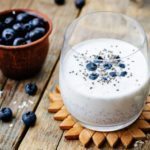The Low FODMAP Carrot Ginger Dressing Salad is a terrific alternative to the classic Japanese restaurant-style salad which is generally loaded high FODMAP onions, garlic, honey or corn syrup. I love this dressing because it’s so creamy, tangy, zesty, sweet and flavorful but very healthy!
The dressing is great on lettuce, kale, spinach, cabbage or any low FODMAP salad but be sure to skip the edamame! You can also use the salad base from the Thai Salad with Peanut Dressing. Or, drizzle on steamed vegetables like spinach or Bok Choy. In addition, it can work well as a bright, colorful sauce for grilled chicken or fish.












